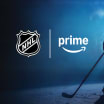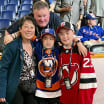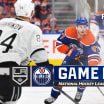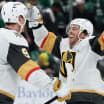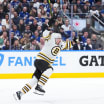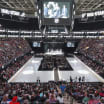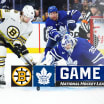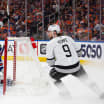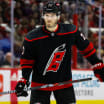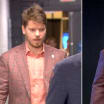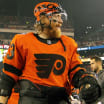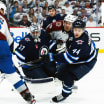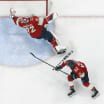The NHL came close to stopping play 75 years ago this month because of World War II.
By far the most critical era endured by the League occurred after the start of the war in September 1939 and the United States' entry into the conflict in December 1941.
NHL came close to shutting down during World War II
League continued on as way to boost morale
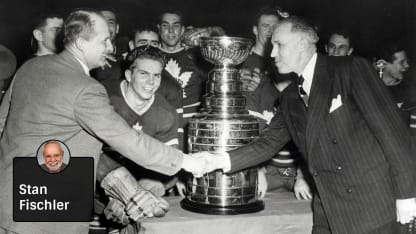
By
Stan Fischler
Special to NHL.com
Closing down pro hockey was seriously considered on each side of the border. Canadian politicians, in particular, believed the NHL should do the patriotic thing and go into hibernation for the duration of the war. This view was articulated by J.L Ralston, Canada's minister of defense.
Ironically, it was a prominent American lawyer and statesman, Charles Sawyer, who was dispatched by the NHL and the American Hockey League to lobby the anti-hockey politicians in Canada. He delivered the following message:
"We Americans are as anxious as the most loyal Canadians to win this war. [But] we want to keep up our morale. We must not sit and brood when the day's work is done, but live our normal lives so we can back up our fighting forces overseas.
"We do not want a single man who is fit for some form of military service to be allowed to play hockey. But let's have the rejects, or average players, to fill the ranks until the boys come home from marching."
The most persuasive pro-play lobbying was provided by the director of Canada's National Selective Services, which was concerned about the public's morale.
As if to second the motion, NHL owners issued a decree at their semi-annual meeting in Toronto on Sept. 28, 1942. Canadian author Ricky Black, in an article titled "Canadiens' Cold War Coup," summed up the general feeling.
"After much deliberation, hockey was given the go-ahead but with [the] important understanding that no player would be absolved from military duty in order to play hockey."
Finally, the NHL said, as a matter of general policy, "it was opposed to employment by any club of any person who should properly be in active service for his country."
Further supporting the League's cause was the fact that NHL President Red Dutton had been a World War I hero and had recently lost two sons, airmen in the Royal Canadian Air Force, during World War II.
"The military status of every player of the NHL is known to the government," Dutton said. "All the players have either been rejected or discharged as medically unfit, or are deferred as farmers on seasonal work."
Even off the ice, the NHL contributed mightily to the war effort. Money was raised through benefit games, and players bought victory bonds. There were also other means, some of them quite unusual.
"Following a stick-swinging incident between Toronto's Gaye Stewart and Detroit's Jimmy Orlando," Black wrote, "Red Dutton not only barred each player from playing in the other's city, but forced each of the belligerents to contribute $100 to the Red Cross immediately."
As more and more NHL players enlisted in the armed forces, service teams organized in Canada and the United States. There also was the War Industries Hockey League, with teams that included the Canadian Vickers, Fairchild Aircraft and Canadian Car.
In Boston, the Bruins' famous "Kraut Line" of Milt Schmidt, Bobby Bauer and Woody Dumart joined the Royal Canadian Air Force as a unit and eventually wound up playing for an RCAF team in England, where the three were based.
In the United States, a powerful service team was located at the Coast Guard yard at Curtis Bay in Baltimore. The Coast Guard Cutters included defenseman Art Coulter and goalie Frank Brimsek, each a future Hockey Hall of Famer. They played in the Eastern Amateur Hockey League and won two straight national championships before heading to the war zone.
Not surprisingly, the talent drain in the NHL was felt in terms of quality and quantity.
"After three years of war, the ranks of the NHL teams have been depleted to the point where the vacancies must be filled by lads only a year or two out of their knickerbockers," Dink Carroll wrote in the Montreal Gazette. "In the ordinary course of events they might still expect to play a year to two of Junior hockey -- or perhaps go to the minors for a year's seasoning -- but these are not ordinary times."
A year after his Maple Leafs had won the Stanley Cup in 1942, coach Hap Day checked his wartime roster and uttered this deathless quote: "It appears that we have reached 'The Children's Hour' in the NHL."
The public didn't seem to mind. NHL attendance actually increased; in 1944, the Maple Leafs played to 88.6 percent of capacity, and the Canadiens 100 percent. The four U.S. teams enjoyed crowd boosts as well. The fact that the NHL abolished overtime for the duration didn't diminish the fan enthusiasm.
Perhaps no single individual did more to boost the morale of service personnel and fans than legendary Canadian broadcaster Foster Hewitt. His "Hockey Night in Canada" radio broadcasts, according to a national survey, reached 74 percent of Canadians. Broadcasts also were sent overseas to servicemen. One report stated that a Canadian officer said his men overseas wanted hockey broadcasts more than anything else, including cigarettes and parcels.
But the broadcasts were good for more than just a morale boost.
"The RCAF once urgently needed field glasses with a power and quality that manufacturers could not immediately supply,' Hewitt said. "We rebroadcast this need during intermissions, with the result that 1,116 instruments were promptly offered and 440 were accepted to the Air Force use."
Each team had many players who were on active service during the war. In hockey's "Victory Lineup" at the start of the 1942-43 season, the Boston Bruins had 16 players, the Canadiens 11, the Chicago Black Hawks seven, the Brooklyn Americans eight, the Detroit Red Wings eight, the New York Rangers 19 and the Maple Leafs 14.
Many players who had been stars before joining the armed forces lost their speed, creativity and ability to play at the NHL level. The Rangers, who had finished first in 1941-42, missed the Stanley Cup Playoffs the next five seasons.
The Maple Leafs were the team that best emerged from the conflict, which ended in 1945. Beginning in 1946-47, with a blend of rookies and what owner Conn Smythe -- a decorated and wounded hero in both world wars -- called "old pappy guys," Toronto became the first team in NHL history to win three straight Stanley Cup championships and four in five seasons, becoming hockey's first dynasty.
